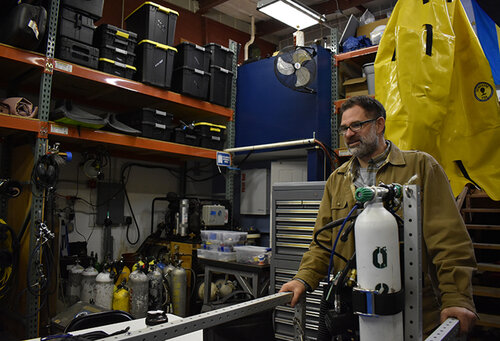By TIM FAULKNER/ecoRI
News staff
 |
| Jeffrey Willis (ecoRI photo) |
Fugate, who in 1986 became the agency’s first director, has no immediate plans other than to spend more time with family.
During an April 14 video
meeting, CRMC’s governing board approved deputy director Jeffrey Willis to
serve as acting director until Fugate’s replacement is hired.
Willis will take on the
duties of executive director while continuing his current responsibilities. He
said he intends to apply for the director position.
Several members of the
CRMC board spoke enthusiastically about Willis serving as interim director.
CRMC chairwoman Jennifer
Cervenka said Willis “is well liked and trusted by this council.”
If he stays on, Willis will likely surpass Fugate’s 34-year tenure. Willis began his career at CRMC as an intern 32 years ago.
CRMC is one of the few
state agencies where the director isn’t nominated by the governor and approved
by the Senate. The agency’s executive director is hired by the nine-member
citizen board, plus the director of the Rhode Island Department of
Environmental Management (DEM). CRMC members and the DEM director are nominated
by the governor and approved by the Senate.
The position will pay an
annually salary between $126,261 and $141,867. Duties include running a
30-person staff, overseeing a $2.8 million state budget and $1.6 million in
federal grants, and managing permitting for coastal and near-shore development.
The agency has received
national accolades for it special area management plans
(SAMPs) that offer management tools for offshore wind development, aquaculture,
and beach use.
In addition to
processing building permits, CRMC will be busy in the months and years ahead
conducting consistency reviews for a number of proposed offshore wind
facilities.
At least one project, Revolution Wind, will require permitting from CRMC to allow the placement of a power cable through Rhode Island waters and its connection to shore at Quonset Point in North Kingstown.
At least one project, Revolution Wind, will require permitting from CRMC to allow the placement of a power cable through Rhode Island waters and its connection to shore at Quonset Point in North Kingstown.
Coastal barriers
At its virtual meeting last week the council also approved the use of new shoreline barriers for coastal property owners. In addition to stone walls, such as bulkheads and riprap, hybrid walls with a stone base and vegetation or biodegradable materials are now allowed under certain circumstances.
CRMC will encourage use of these hybrid barriers to builders in place of the stone and steel walls, which tend to increase erosion and cause other environmental damage.
At its virtual meeting last week the council also approved the use of new shoreline barriers for coastal property owners. In addition to stone walls, such as bulkheads and riprap, hybrid walls with a stone base and vegetation or biodegradable materials are now allowed under certain circumstances.
CRMC will encourage use of these hybrid barriers to builders in place of the stone and steel walls, which tend to increase erosion and cause other environmental damage.
Building new stone,
steel, hybrid, and other man-made barriers are still prohibited along the Ocean
State’s shoreline. These barriers are also forbidden to reclaim shoreline lost
to erosion or a storm. But a new provision allows new barriers if they aid in
creating or restoring a marsh.
An exception was also
created to allow new seawalls and bulkheads if they serve a water-dependent-use
area, such as an industrial waterfront, high-intensity boating area, or a
commercial or recreational harbor. All other options must be ruled out before
the stone or steel walls are permitted.
Floating offshore wind
turbines
Such turbines are no longer a concept for local waters, but are closer to becoming a reality off Scotland, in the Gulf of Maine, and some other places.
This design is preferred for rocky and deep ocean floors, which are impractical for pile driving steel posts. Floating turbines are anchored by tethers to the seafloor. The tethers have raised concerns about entanglements with commercial fishing gear.
Such turbines are no longer a concept for local waters, but are closer to becoming a reality off Scotland, in the Gulf of Maine, and some other places.
This design is preferred for rocky and deep ocean floors, which are impractical for pile driving steel posts. Floating turbines are anchored by tethers to the seafloor. The tethers have raised concerns about entanglements with commercial fishing gear.
CRMC coastal policy
analyst James Boyd told ecoRI News that he doesn't expect to see floating
turbines installed at any of the wind facilities proposed off southeastern New
England.
The water is relatively shallow compared to Maine and has ample sandy areas that are hospitable to pile driving.
The water is relatively shallow compared to Maine and has ample sandy areas that are hospitable to pile driving.
New turbines in the
region will also sit atop single “monopoles” rather than the multi-pile
platforms used at the five-turbine Block Island Wind Farm.
COVID-19
Fugate reported that only eight staff members are working regularly at the CRMC office in Wakefield, while the rest work from home. The Stedman Government Center, which also houses a branch of the Department of Motor Vehicles, is closed to the public because of the global pandemic. Applications for development are being processed electronically by CRMC staff.
Fugate reported that only eight staff members are working regularly at the CRMC office in Wakefield, while the rest work from home. The Stedman Government Center, which also houses a branch of the Department of Motor Vehicles, is closed to the public because of the global pandemic. Applications for development are being processed electronically by CRMC staff.
“We are still engaging
in our meetings and duties to the extent that we can,” Fugate said. “We’re
functioning.”